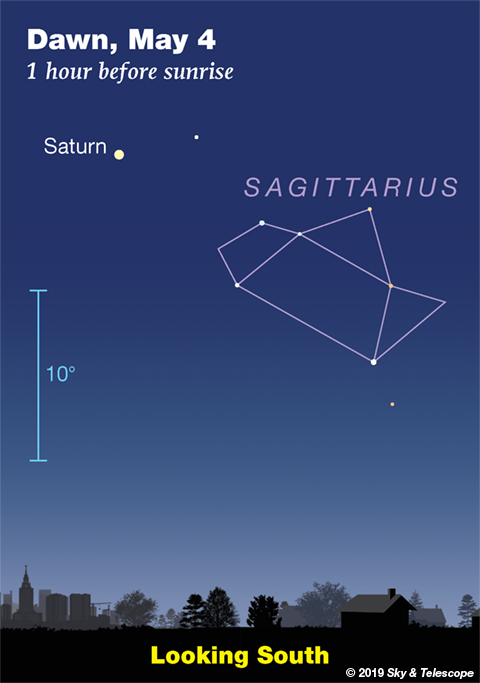
Friday, May 3
• Three zero-magnitude stars shine after dark in May: Arcturus high in the southeast, Vega much lower in the northeast, and Capella in the northwest. They appear so bright because each is at least 60 times as luminous as the Sun, and because they're all relatively nearby: 37, 25, and 42 light-years from us, respectively.
Saturday, May 4
• Vega is the brightest star in the northeast late these evenings. Look 14° (about a fist and a half at arm's length) to Vega's upper left for Eltanin, the nose of Draco the Dragon. Closer above and upper left of Eltanin are the three fainter stars of Draco's stick-figure head, also called the Lozenge. Draco always points his nose to Vega no matter in what part of the sky we see them. He seems awfully curious about it. Do dragons eat jewels?
The faintest star of Draco's head, opposite Eltanin, is 4th-magnitude Nu Draconis. It's a lovely, equal-brightness double star for binoculars and small scopes (separation 61 arcseconds).
• New Moon (exact at 6:46 p.m. EDT).
Sunday, May 5
• As night descends, look high in the west for Pollux and Castor lined up almost horizontally (depending on your latitude). These two stars, the heads of the Gemini twins, form the top of the enormous Arch of Spring. To their lower left is Procyon, the left end of the Arch. Farther to their lower right is the other end, formed by Menkalinan (Beta Aurigae) and then brilliant Capella. The whole thing sinks lower through the evening.
• Before the Moon returns to brighten the evening sky, learn to find (once and for all!) the famous galaxies M81 and M82 by using the faint "Mini-Dipper" attached to the Big Dipper's lip. See Matt Wedel's Binocular Highlight column and chart in the May Sky & Telescope, page 43.
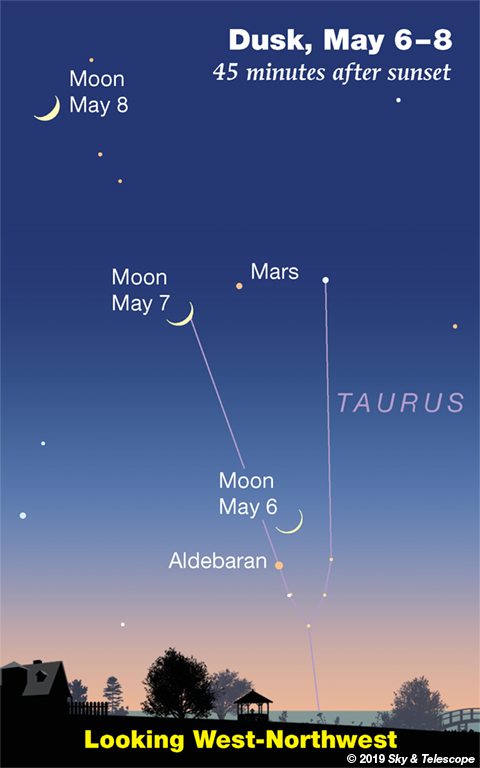
Because we always show the Moon three times its actual apparent size in these scenes, it seems here to be occulting Zeta Tauri on May 7th. In fact it will cover the star in the U.S. only for Florida, the deep south, and the mid-south. See the text for May 7.
Monday, May 6
• As twilight fades, look low in the west-northwest for the thin crescent Moon a few degrees above Aldebaran as shown here.
Tuesday, May 7
•The crescent Moon hangs in the west-northwest at dusk near Mars and Beta Tauri (which is to Mars's left), and very close to or even on top of 3rd-magnitude Zeta Tauri.
Will the Moon occult Zeta for your location? It will if you're in Florida or the deep south (where the Moon will be low in darkness), the mid-south (with the Moon higher in twilight), or much of Mexico and Central America. See map and timetables from IOTA. (The text there consists of three timetables: for the star's disappearance, its reappearance, and the locations of the cities and towns. Watch for the divisions between the tables as you scroll.)
Wednesday, May 8
• The crescent Moon this evening shines in the feet of Gemini, far below Pollux and Castor. While twilight is still fading, look for Betelgeuse twinkling a similar distance below the Moon.
• Arcturus is the brightest star high in the east these evenings. Spica shines lower right of it by about three fists at arm's length. To the right or lower right of Spica, by half that distance, is the distinctive four-star constellation of Corvus, the Crow of Spring.
Thursday, May 9
• The thick crescent Moon shines in the west after dusk, with Pollux and Castor to its upper right and Procyon farther to its lower left.
• Summer is more than five weeks away, but the Summer Triangle is making its appearance in the east, one star after another. The first in view is Vega, already low in the northeast as twilight fades.
Next up is Deneb, lower left of Vega by two or three fists at arm's length. It comes above the horizon around when twilight fades into full night (depending on your latitude).
The third is Altair, which shows up far to their lower right around 11 or midnight.
Friday, May 10
• The Moon, nearly first quarter, crosses the Beehive star cluster (M44) this evening for much of North America. Many faint occultations will be visible telescopically on the Moon's dark limb, writes David Dunham: "Occultations of 6th to 9th-magnitude stars in rapid succession will occur as the 39% sunlit Moon passes over M44, visible in part from most of North America east of the Rocky Mountains with northeastern areas favored. A Moonview and information about computing local predictions is on the newly updated IOTA occultation campaigns page." (The Universal Time date is May 11th.) See our article The Moon Bumbles Into the Beehive Friday.
Saturday, May 11
• First-quarter Moon (exact at 9:12 p.m. Eastern Daylight Time). The Moon shines some 10° to the right of Regulus. Above Regulus is Algieba (Gamma Leonis), only a little fainter. They're the two brightest stars of the Sickle of Leo.
________________________
Want to become a better astronomer? Learn your way around the constellations. They're the key to locating everything fainter and deeper to hunt with binoculars or a telescope.
This is an outdoor nature hobby. For an easy-to-use constellation guide covering the whole evening sky, use the big monthly map in the center of each issue of Sky & Telescope, the essential guide to astronomy.

Once you get a telescope, to put it to good use you'll need a detailed, large-scale sky atlas (set of charts). The basic standard is the Pocket Sky Atlas (in either the original or Jumbo Edition), which shows stars to magnitude 7.6.
Next up is the larger and deeper Sky Atlas 2000.0, plotting stars to magnitude 8.5; nearly three times as many. The next up, once you know your way around, are the even larger Interstellarum atlas (stars to magnitude 9.5) and Uranometria 2000.0 (stars to magnitude 9.75). And read how to use sky charts with a telescope.
You'll also want a good deep-sky guidebook, such as Sue French's Deep-Sky Wonders collection (which includes its own charts), Sky Atlas 2000.0 Companion by Strong and Sinnott, or the bigger Night Sky Observer's Guide by Kepple and Sanner.
Can a computerized telescope replace charts? Not for beginners, I don't think, and not on mounts and tripods that are less than top-quality mechanically (meaning heavy and expensive). And as Terence Dickinson and Alan Dyer say in their Backyard Astronomer's Guide, "A full appreciation of the universe cannot come without developing the skills to find things in the sky and understanding how the sky works. This knowledge comes only by spending time under the stars with star maps in hand."
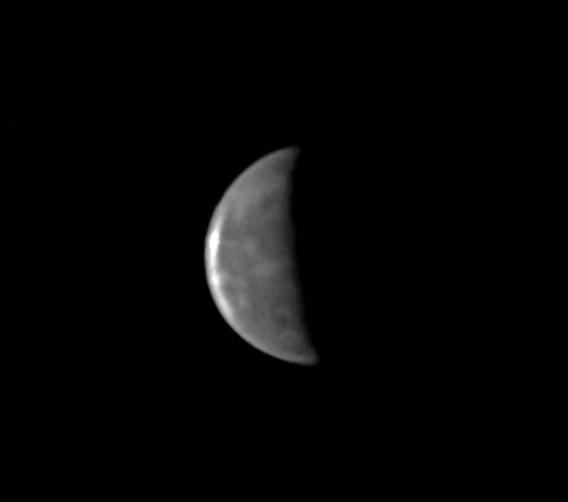
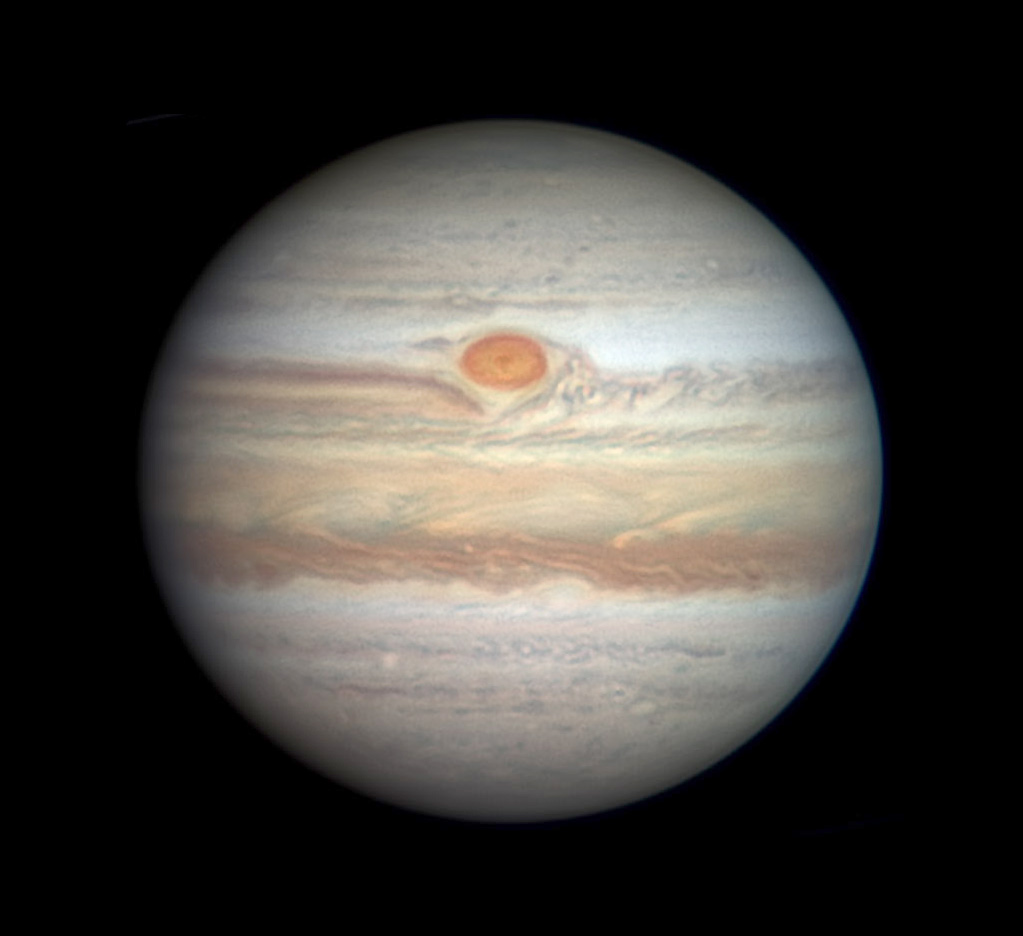
To mimic Jupiter's appearance in amateur scopes of various sizes in very steady seeing, turn your screen to maximum brightness and view this image from the far side of the room while squinting your eyes to various degrees. Study the view as carefully as you can; take your time. What are the finest details you detect that turn out to be real when you come closer?
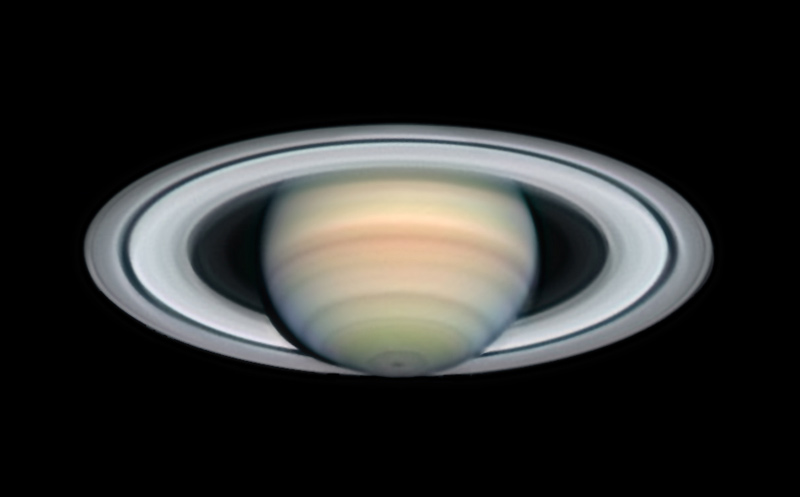
Mercury is lost in the glare of sunrise, far lower left of Venus.
Venus (magnitude –3.8) is very low in the brightening dawn. Just 20 minutes or so before sunrise, look for it a little above the horizon exactly due east. Bring binoculars.
Mars (magnitude +1.7, in Taurus) is getting low in the west during and after dusk. This week it's passing between the horn-tips of Taurus, Beta and Zeta Tauri. Find this array far lower left of bright Capella, and farther lower right of Pollux and Castor. The thin crescent Moon joins them on May 7th.
Don't confuse Mars with brighter orange Betelgeuse about 17° to its left or lower left.
Jupiter (magnitude –2.5, still at the eastern foot of Ophiuchus) rises in the southeast around 11 p.m. daylight-saving time. It shines highest in the south around 3 or 4 a.m., well before dawn begins, with orange Antares twinkling 14° to its lower right.
In a telescope Jupiter has grown to a good 44 arcseconds wide as it approaches its June 10th opposition. See Richard Jakiel's Jupiter observing guide in the May Sky & Telescope, page 52.
Saturn (magnitude +0.4, in Sagittarius) rises around 1 a.m. Before dawn, it's the "star" 27° (almost three fists at arm's length) to Jupiter's left.
Uranus is hidden deep in the glow of dawn.
Neptune barely rises before dawn begins to brighten.
______________________
All descriptions that relate to your horizon — including the words up, down, right, and left — are written for the world's mid-northern latitudes. Descriptions that also depend on longitude (mainly Moon positions) are for North America.
Eastern Daylight Time (EDT) is Universal Time (UT, UTC, GMT, or Z time) minus 4 hours.
______________________
Audio sky tour. Out under the evening sky with your earbuds in place, listen to Kelly Beatty's monthly podcast tour of the heavens above. It's free.
______________________
"We may be little guys, but we don’t think small. It’s the courage of questions, of grasping our true circumstances, and not pretending we are at the center of it all, that is adulthood."
– Ann Druyan, 2014
______________________
 3
3








Comments
Rod
May 3, 2019 at 9:15 am
I was out early this morning shortly after 0500 EDT. Jupiter is putting on the show now with 44" size in telescope view. Retrograding in Ophiuchus. Saturn is starting to put on its show too as it approaches opposition in early July and retrograding in Sagittarius. Lovely Cassini division and Titan, easy moon to see using my 90-mm refractor. Last night, t-storms, rain and clouds. Clearer this morning. Sunrise at my location in Maryland near 0607 EDT.
You must be logged in to post a comment.
mary beth
May 8, 2019 at 2:06 pm
Hope you’re getting some better weather! Unfortunately will be cloudy through next Tuesday. I am really looking forward two Saturn the summer, thank you for letting me know! Even with clouds I can usually see Jupiter or at least the light of Jupiter behind clouds.
You must be logged in to post a comment.
Rod
May 9, 2019 at 7:34 am
mary beth, mixed weather here for me in Maryland. I posted a note on Bob King's Eta Aquariids for my observation, early 04-May shortly after 0330 EDT. More grass cutting and weed whacking too :). On 06-May near 2200 EDT, I enjoyed the binary star system, Porrima in Virgo. Very good double star system for telescopes. Yesterday near 0800 EDT, I observed two large sunspots, larger than earth size, enjoyed excellent views of 2740 and 2741 sunspots. Today, clouds and some rain on the way. It does not look good for my location to observe the Moon passing through the Beehive star cluster Friday night. Bob King has a good report on the event.
You must be logged in to post a comment.
You must be logged in to post a comment.